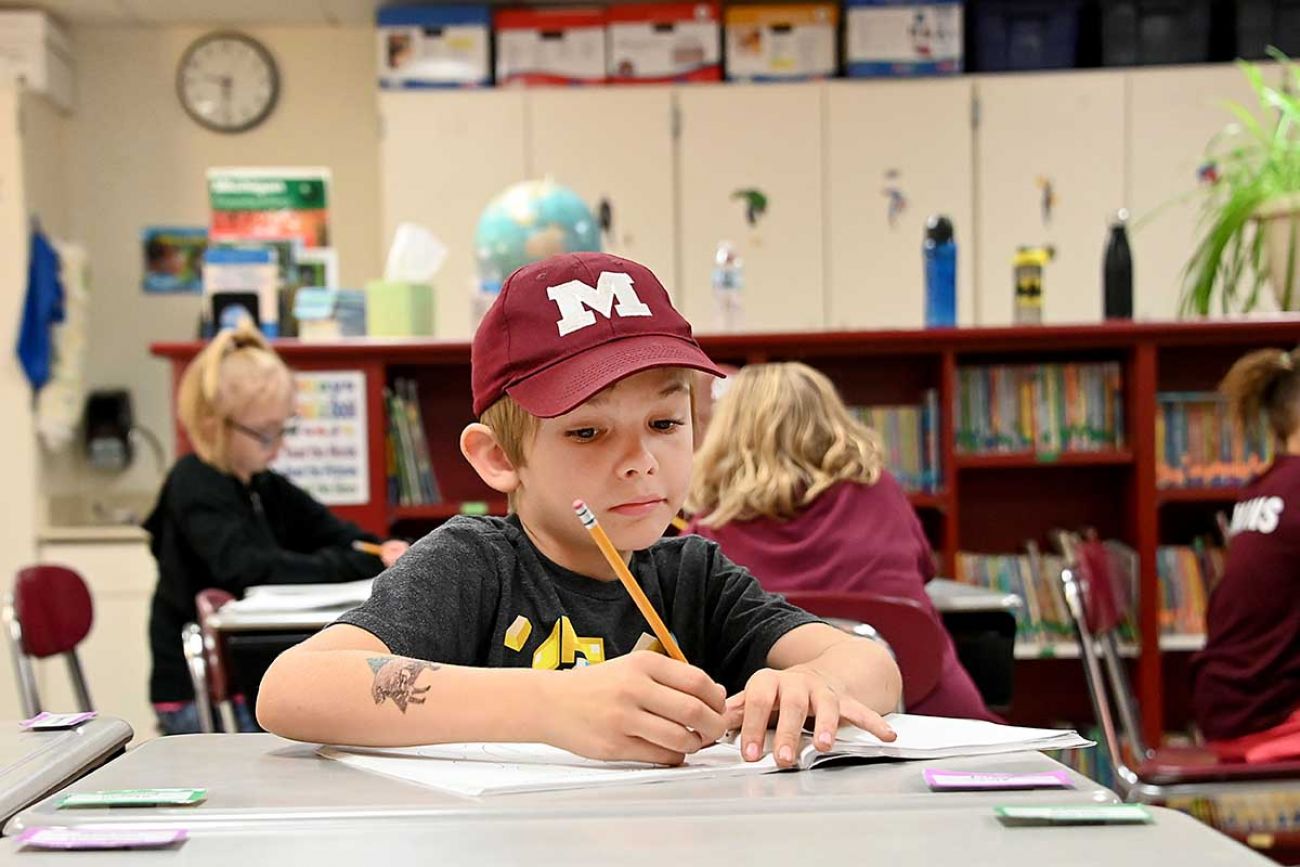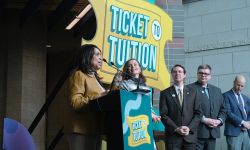How can Michigan schools spend $6B in COVID money? Here’s what experts say

Aug. 16: How Michigan schools are spending $6 billion in federal COVID relief
Congress has now injected over $6 billion into Michigan’s public schools through three COVID relief packages since the pandemic began in the spring of 2020. Individual districts and charter schools are facing a question that was unthinkable in recent years:
How do we spend the money?
School leaders accustomed each summer to figuring out how to balance ever-tightening budgets are now looking at wish lists, wondering where they can get the biggest bang for their federal bucks.
Related:
- Whitmer vetoes plan to give $1,000 scholarships for elementary reading help
- Michigan lawmakers pass ‘historic’ $17B plan for schools to close funding gap
- Michigan’s top doc urges schools to require facemasks in the fall
- Michigan legislation would de-emphasize SAT scores to boost college access
Schools have until 2024 to spend stimulus funds, which can be used for a broad range of needs. There’s no shortage of worthy projects, from delayed maintenance on school buildings, to programs to increase college enrollment, to efforts to address the academic and emotional needs of children emerging from the pandemic.
Using that money wisely is critical to Michigan schools, which are, at best, middle of the academic pack in the nation, and where students will be returning in the fall after a challenging pandemic school year.
Bridge Michigan asked a selection of Michigan education experts to weigh in on how schools can best use their federal funds. Their suggestions ranged from school building improvements to early literacy help, to hiring and retention bonuses to address the state’s teacher shortage.
Amber Arellano, executive director, Education Trust-Midwest
Help the young and those about to graduate
The federal stimulus funding is a historic investment in public education, critical to unfinished learning. The fact remains, however, that these one-time dollars will run out. As Michigan leaders consider how to spend the last of these funds – nearly $370 million in discretionary federal funding – they should commit to transforming our unfair school funding system, which is one of the bottom five states nationally for the funding gap between high-poverty and low-poverty districts.
These dollars represent an exceptional opportunity for Michigan to make a down payment for educational equity through systemic investments in underserved students. By investing intentionally in improving early literacy through expanded summer learning, intensive tutoring and competitive literacy grants, we can set our youngest learners up for success, regardless of where they enter or existing gaps.
Michigan lawmakers should also focus on the needs of students who have recently graduated or will be graduating in the next few years. Through investments in summer bridge programs, no-cost postsecondary remediation, greater access to postsecondary advising throughout high school and reengagement with students who dropped out during the pandemic or didn’t continue to postsecondary following graduation. Through targeted efforts, Michigan can begin to address our broader talent crisis, as well as the unacceptable inequities in postsecondary access and success.
We must also hold schools accountable for effectively spending new dollars and improving student outcomes. Through well-designed systems of strong fiscal accountability and transparency, we can ensure public education dollars are spent effectively on the students for whom these investments are intended to benefit. Only through transparency in how these funds are spent and the impact they had can we inform future investments and ensure that every dollar for education has the greatest impact possible.
Michigan must consider the successes and examples of leading education states that have made transformative changes in the way they fund schools to ensure that all students to have opportunities to achieve at high levels, including Black and Brown students, English learners, students with disabilities and low-income students. Transforming our funding system into one that supports students according to their diverse needs and guarantees that new dollars go first to those who are the most underserved is critical as state leaders prioritize the spending of this federal stimulus funding.
Elizabeth Moje, dean, School of Education, University of Michigan
New technology and teacher training
- Purchase technology tools for classrooms and training for teachers
A popular topic of conversation of late has been how technology tools can be leveraged to intervene on so-called “learning loss.” And it’s true that teachers and schools are perfectly positioned after the past year to creatively and meaningfully integrate technology tools into their instructional practice.
However, decision makers need to rely on expertise and scholarship as they invest in tools that will actually help students learn more effectively. Too many tools offer eye-catching bells and whistles, but do not generate deep learning. Too many tools promise to reach thousands of students simultaneously, offering personalized, just-in-time supports. Some tools can do that. But we need to be sure that we are employing evidence-based tools, designed with learning, rather than profits, in mind.
Moreover, resources should be dedicated to high-quality instructional technology training for both teachers and school leaders so that these powerful technology tools will not sit on shelves.
- Better support for students’ social, emotional and physical development.
The need for improved socioemotional learning and development in schools was evident prior to the pandemic. Schools are welcoming back into their environments whole humans who have lived through life-altering events. This year has also highlighted the need to be more attentive to the health determinants of learning, which include health care, dental care, safe and supportive environments, food access, and social-emotional health and well-being. Each of these dimensions of health has a significant effect on the extent to which children can take up opportunities to learn.
And in some cases, these health determinants may affect the ways teachers and leaders offer opportunities to learn, particularly if they assume that the hungry or tired or stressed child is unmotivated or unable to self-regulate in ways that comport well with classroom organization.
These health determinants, as we have been reminded throughout our twin pandemics of COVID-19 and racial injustice, are unevenly distributed across racial, ethnic and socioeconomic lines, thus shaping the learning opportunities of Black children, Indigenous children, children of color and children who live in economically challenged conditions.
And yet, pre-pandemic declines in school funding in the past decades have whittled away supports for students outside of the classroom, leaving teachers responsible for students’ learning as well as wellness, counseling and instructional and behavioral interventions.
We need to offer individual socioemotional supports while continuing to develop practices and policies that incorporate socioemotional learning (SEL) and restorative practices, thus fostering caring and just environments for all. Students require and deserve expert support in these areas — especially from literacy specialists, mathematics specialists, SEL specialists, nurses and social workers. Moreover, teachers need these specialists to work directly with children so that teachers can continue to teach.
The last thing we need is for teachers to hold back from teaching children concepts and skills because they are spending their time trying to wrestle with the very real challenges that children are facing. In short, we need teams of classroom teachers and support specialists who can work together with children and their families to provide the very best — and most equitable — opportunities to learn.
- Professional development for teachers.
Educators need access to professional learning that allows them to develop a range of skills to support continued student learning as they emerge from the pandemic. High-quality opportunities will center a growth mindset over a deficit approach, and will assist educators in developing evidence-based, culturally sustaining, and socially meaningful instructional practices.
Educators – whose lives were also altered during the pandemic – must be equipped with skills to understand and address trauma, hardship and isolation experienced by many students and families and how it may affect students’ learning. Not only should we offer teachers support services in the form of other specialists who can work side by side with teachers and learners, but teachers themselves need coaches to learn how to hone their skills of attending to the real trauma that children have experienced and will continue to experience.
Teachers need support in understanding that trauma does not exist within learners; children have experienced trauma and it is our society’s responsibility to grapple with reducing trauma, not the learners’ responsibility. Although we can teach children to manage the products of trauma, we should never reduce them to victim status or locate the source of their trauma within them.
This one-time infusion of funds begs the question, how can we sustain our successes? What is the best way to advance just and equitable education for all children, youth and adults? The most important thing we can do is ensure our educators continue to be educated at a high level—higher than ever before.
Teaching is a profession that requires expertise, nuanced professional judgment and learned skills. To thrive and survive requires a foundation of high-quality training, guided practice and continued support into the early career and beyond. Our educators need—and deserve—all we can equip them with to successfully navigate the myriad needs of our children and youth coming out of a pandemic and a time of great upheaval.
Paula Herbert, president, Michigan Education Association teacher union
Recruit – and pay – teachers
Federal COVID relief funding, finally distributed by the Legislature after months of delay, will provide a game-changing opportunity to invest in our students and schools. In particular, these funds can make a huge difference in two long-standing issues worsened by the pandemic: the educator shortage and aging school infrastructure.
Much has been written about the shortage of teachers and other professionals to serve students in Michigan schools. This was a crisis already before the pandemic made it worse, driven by a mix of retiring educators, early departures from the profession and declining enrollment in teacher preparation programs.
Local districts can use these funds to raise salaries to improve recruitment and retention of educators to meet student needs. Michigan ranks 41st nationally in starting teacher salary, an important metric in attracting people to a profession that is essential for student success.
Funds can also go toward paying off student debt for educators, compensating student teachers for the internships they must complete to get their degrees and adding positions and pay for non-teachers who meet critical student needs – from school nurses and counselors to bus drivers and paraprofessionals.
These decisions – which need to be made locally with input from school employees and community members – will ensure students have access to educators committed to their success, academically and in life beyond the four walls of our schools.
Like the educator shortage, problems stemming from Michigan’s aging school buildings were present long before COVID-19. The pandemic put a finer point on many of these issues: windows that won’t open, poor ventilation, inadequate heating and air conditioning, and more. School air quality is a frequent concern of educators and parents alike – and a critical focus for school safety during the pandemic.
Federal funds can be used to fix these issues and add equipment that will keep people healthy and safe long after the pandemic. Better air quality, improved ventilation and HVAC systems, and greater investment in cleaning and sanitization will not only help stop COVID, but will also prevent outbreaks of colds, flus and other illnesses that frequently roll through school buildings.
Such improvements can often be done by local contractors and tradespeople, helping improve our local economies while helping students and staff be safer and healthier in our schools.
Long term, this infusion of cash won’t permanently solve these issues. However, in the short run, this funding can go a long way to helping students succeed and showing our communities what’s possible when we properly fund our schools.
Ben DeGrow, director of education policy, Mackinac Center for Public Policy
Keep optional virtual learning
Local school leaders have a unique opportunity: Use extra funds to restore some of the confidence families lost during the pandemic. While some students thrived in a full-time online setting, many more languished, especially in districts that dragged their feet to reopen classrooms and left families with few options. School leaders must consider how the new funds can fix shortcomings, or risk pushing more desperate families to pursue education elsewhere.
Improving services will require more flexibility. At minimum, districts should include options for both in-person and virtual learning. Rather than adopt an all-or-nothing approach, local leaders should deploy teachers who excel at online education and recruit students to take virtual courses. For their part, state lawmakers could let dollars follow students at the course level, as outlined in the Mackinac Center’s Flex Learning proposal.
Families want fresh, student-centered approaches from their public schools. A recent national survey of 2,700 parents found 40 percent are very concerned about setbacks in student learning. Nearly 60 percent favored using federal funds to make “bold changes,” an opinion that cut across all demographic groups. High on the list of changes: offering students more ways to earn college credit or complete apprenticeships and other work-based learning opportunities. Expanding student access to high-quality tutoring and mental health services to meet individual needs gained strong support, too.
Unfortunately, early indicators suggest local education officials around the nation are following far less effective paths. Most districts monitored by the Edunomics Lab at Georgetown University plan to use the one-time funds to increase staffing or provide “thank-you” bonuses. They are both missing an opportunity to employ effective strategies and setting up serious future budget challenges.
Whatever decisions Michigan school boards make, they should heed an important lesson from the pandemic: Business as usual isn’t good enough.
Mike Flanagan, former state superintendent
More Pre-K, and decrease elementary class size
I would use it on two things: 3- and 4-year old early childhood and lower class sizes in early elementary to get the biggest bang for the bucks. Then kids would be well prepared to read (learn to read, then read to learn).
In an ideal world, Michigan would continue that funding. But if not, I would then take the years before the windfall ran out institutionalizing both of those in my district by reducing or eliminating less proven, time-worn strategies.
Craig Thiel, research director, Citizens Research Council of Michigan
Facility improvements
Although plentiful, schools should proceed with caution in their use of federal funds.
To begin, schools must recognize that these are one-time funds and budget accordingly. Given the fact that the federal money is being layered on top of a growing state revenue base, districts are advised against programming the money as replacement revenue in their on-going operational budgets. There is no need to back-fill education cuts because dedicated school operating revenues remain strong, and Lansing kept K-12 schools financially whole throughout the pandemic.
Budgeting the money as temporary will head off future budget challenges; avoiding a “fiscal cliff” that would require them to shutter programs and lay off employees when the money eventually runs out.
Instead, school officials should look to address their one-time, short-term needs with a particular focus on the immediate impacts arising from the pandemic. To this end, Congress directed that 20 percent of the money ($670 million statewide) must be used to address learning loss through the implementation of “evidence-based interventions” and ensure that those interventions respond to students’ social, emotional and academic needs and address the disproportionate impact of COVID-19 on underrepresented student subgroups.
What these learning loss efforts will entail, how they will look, and how they will be implemented is going to be unique to individual students and schools. In some cases, this might look like extended classroom time/school year, tutoring, and/or new delivery models. Congress required districts to gather local input and finalize spending plans by the end of August.
That leaves $2.7 billion (statewide) in discretionary dollars. One area that merits serious attention is facility improvements and repairs. The scale of federal funds will allow some districts to make measurable improvements to their aging infrastructure, a long-standing financing challenge faced by many poorer districts, The Detroit Public Schools Community District has an estimated $530 million need across nearly 100 buildings. It is doing the right thing by spending some of its $800-plus million federal award on building improvements.
Sherry Sparks, education consultant, former teacher, principal, curriculum director, superintendent
Gifted and talented programs
Michigan has abundant funds for education right now and the golden opportunity to reverse decades of disappointing student academic results measured by state-mandated tests.
Michigan governors, legislators, superintendents and teachers once knew the difference between a high-quality gifted education and regular education, but that is no longer true. After Michigan permanently cut gifted and talented funding, most colleges, universities, and school districts stopped training administrators and teachers in gifted education.
As a result, gifted and talented education curriculum, instructional strategies, and assessments, teaching practices most closely aligned with Michigan’s standards, have been lost in our state.
How has that hurt all Michigan children? No one can know when children are achieving at their highest possible levels until they are given the educational opportunities that maximize their potential. Instead of viewing gifted education as elitist and cutting funding and access to it, why not give every child an opportunity to learn as a gifted student?
If Michigan uses some education funds to train all teachers and administrators in gifted education in every rural, urban and suburban school, every child would have the opportunity and means to maximize their potential. Think what that would mean for the academic prowess of every child and teacher in our state and for Michigan’s future!
Michigan Education Watch
Michigan Education Watch is made possible by generous financial support from:
Subscribe to Michigan Education Watch
See what new members are saying about why they donated to Bridge Michigan:
- “In order for this information to be accurate and unbiased it must be underwritten by its readers, not by special interests.” - Larry S.
- “Not many other media sources report on the topics Bridge does.” - Susan B.
- “Your journalism is outstanding and rare these days.” - Mark S.
If you want to ensure the future of nonpartisan, nonprofit Michigan journalism, please become a member today. You, too, will be asked why you donated and maybe we'll feature your quote next time!






